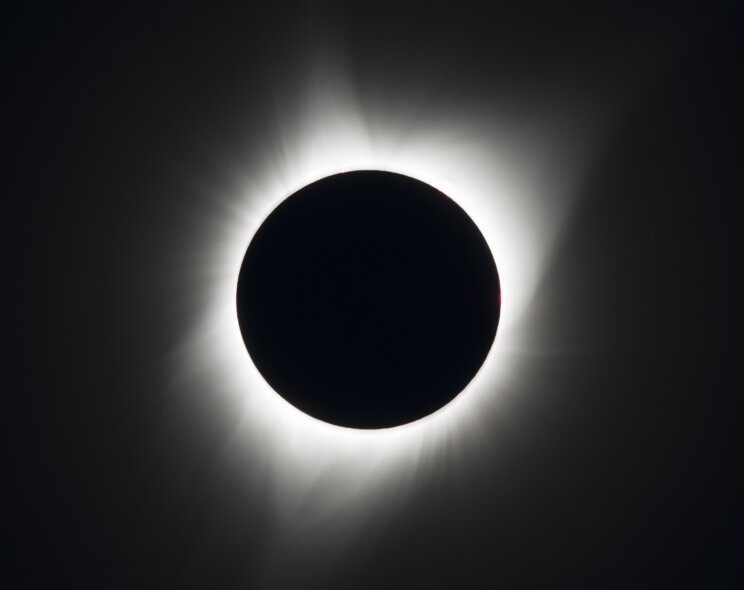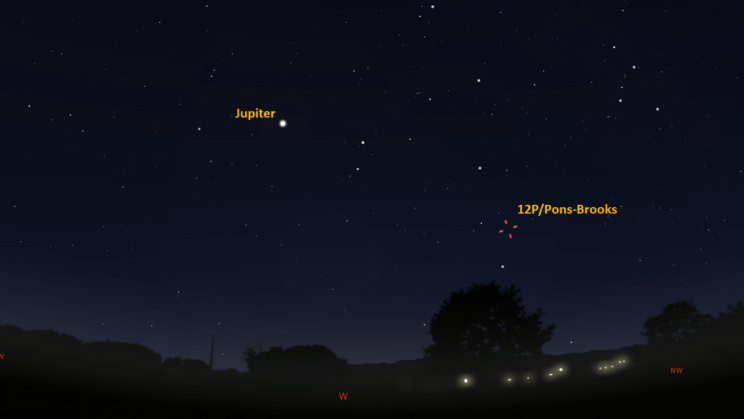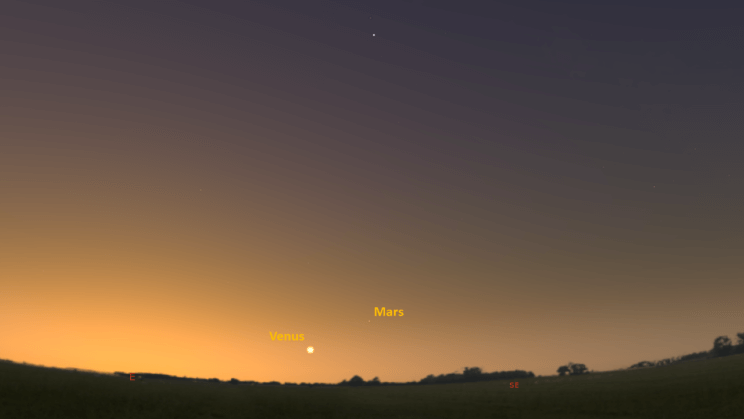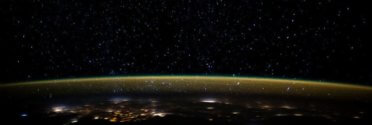This is the Saint Louis Science Center’s NIGHT SKY UPDATE for the week of Saturday, March 9, 2024.
Information updated weekly or as needed.
Times given as local St. Louis time this week changes from Central Standard Time (CST) to Central Daylight Time (CDT). For definitions of terminology used in the night sky update, click the highlighted text. If relying on times posted in Universal Time (UT), St. louis is -6 hours when CST and -5 hours when CDT. The change to CDT occurs on Sunday, March 10, 2024.
Join us for our next star party, Friday, April 5, 2024, held in association with the St. Louis Astronomical Society. For details, see the information at the bottom of this page or visit https://www.slsc.org/explore/mcdonnell-planetarium/public-telescope-viewings/
Observing Highlight of the Week

Total solar eclipse seen from Madras, Oregon on August 21, 2017. Image credit: Aubrey Gemignani.
We are now a month away from the next total solar eclipse visible from North America. Most of North America will see an eclipse on April 8, 2024, but to see totality, you have to travel to a path that runs from Texas through Maine that is only 110 miles wide. For us in St. Louis, that will be a short drive as totality is visible about an hour south. It is highly encouraged that you drive to totality if you can because there are few astronomical events that compare to a total solar eclipse.
If you are still trying to decide where to go to see the eclipse, there are a few things to consider. The right place to go will depend on how you feel about traffic, do you need to see maximum duration and what the weather will be. Additionally, several towns along the path of totality are planning events for April 8. You can find a list of Missouri sites planning events at https://moeclipse.org/2024-tse
The two main routes to see totality from St. Louis are Interstate 55 and Highway 67. Both of these routes will take you through key towns in the path of totality. Expect significant traffic on both, however I-55 is likely to be the heaviest.
While the entire eclipse lasts about 2.5 hours, duration of totality varies depending on how deep into the Moon’s umbral shadow you are. If you get near the center line of totality, you will see just over 4 minutes. Towns such as Doniphan, Jackson, Poplar Bluff and Cape Girardeau Missouri are near the center line. If you are near the edges of the path, you will only see seconds of totality. The right amount will depend on your interest and how far you can travel. Ideally, traveling to the center line would be the best, but two or three minutes of totality will be nice as well. If you are okay with not seeing the maximum duration, places such as Farmington, Fredericktown, Perryville, and Ste. Genevieve Missouri are good options. While I cannot name every town in the path, a good way to find the place that works for you is to use the interactive eclipse map from the National Solar Observatory (NSO). You can find that here.
It is important to remember to see this eclipse, you must use safe solar viewing techniques. The simplest option is to use eclipse glasses. The only time you can look at the eclipse without them is during totality, so it is imperative that you know exactly when totality begins and ends. The resource I prefer for this is an interactive eclipse map from Xavier Jubier. I prefer this map to determine timings because it will give them to you down to a tenth of a second. Keep in mind though, this map uses Universal Time so you will have to adjust for your time zone. If you are viewing the eclipse from Missouri, you will subtract 5 hours from Universal Time. You can find Xavier’s map here.
As for the weather, start looking at the extended forecast about one week before the eclipse. While the extended forecast is not a guarantee of what April 8 will bring us, it will be useful to start deciding on where your best option is. Climatic information suggests that April 8 in southern Missouri is about 50% likely to have some kind of cloud cover. Jay Anderson of eclipsophile.com, has put together a great article discussing the weather outlook based on climate data. Of particular note, he also addresses the impact El Nino may have on potential cloud cover. The good news is the data suggests we are less likely to experience clouds during an El Nino year than others. I would encourage you to read his article which can be found at https://eclipsophile.com/2024tse/
The eclipse is just around the corner so start preparing now. We are starting our solar observing program called Solar Sundays at the planetarium tomorrow March 10, 2024. Every Sunday in March 2024, we will have solar telescopes to look through from 11 am to 3 pm depending on the weather. This will be a good opportunity to come and ask any question regarding the eclipse or concerns you may have. If you are planning to travel to other states along the path of totality, I would encourage you to visit eclipse website from the American Astronomical Society. You can find that at https://eclipse.aas.org/about-us
Comet 12P/Pons-Brooks Update
For those interested in observing periodic comet 12P/Pons-Brooks, it can still be found in the west by 7:00 p.m. Currently, the comet is found in the constellation Andromeda with magnitude estimates near 5.5. At this magnitude urban viewers will still need to use a telescope to spot the comet. If you are in darker skies, this magnitude should be bright enough to see in binoculars. As we approach the comet’s perihelion on April 21, 2024, it should continue to brighten. As we near this perihelion date, we will update this section as new information arises.
The Sun and Moon

The Moon as seen from the International Space Station, on July 31, 2011.
Credit: NASA
Sun
Sunrise is at 6:20 a.m. on Saturday, March 9 and sunset is at 6:02 p.m. providing us over 11.5 hours of daylight this week. By the end of the week, it will be almost 12 hours of daylight. Even after sunset, light from the Sun will dimly illuminate our sky for about 1 hour and 30 minutes. This period is called twilight, which ends around 7:31 p.m. this week. For those with a sundial, local noon occurs around 12:11 p.m. on March 9, 2024. With the time change coming this Sunday, Local noon will shift to being near 1:10 p.m.
| Day | Sunrise | Sunset | ||||||||||
|---|---|---|---|---|---|---|---|---|---|---|---|---|
| 9-Mar | 6:20 a.m. | 6:02 p.m. | ||||||||||
| 10-Mar | 7:19 a.m. | 7:03 p.m. | ||||||||||
| 11-Mar | 7:17 a.m. | 7:04 p.m. | ||||||||||
| 12-Mar | 7:16 a.m. | 7:05 p.m. | ||||||||||
| 13-Mar | 7:14 a.m. | 7:06 p.m. | ||||||||||
| 14-Mar | 7:13 a.m. | 7:07 p.m. | ||||||||||
| 15-Mar | 7:11 a.m. | 7:08 p.m. | ||||||||||
| 16-Mar | 7:09 a.m. | 7:09 p.m. | ||||||||||
| 17-Mar | 7:08 a.m. | 7:10 p.m. |
Moon
Moonrise for Saturday, March 9 was at 6:10 a.m. and moonset occurs at 5:25 p.m. On Saturday, March 9, the Moon will exhibit a waning crescent phase with roughly 1% disk illumination. By the end of the week the Moon will exhibit a waxing gibbous phase with 56% disk illumination. New moon occurs on March 10, 2024, at 9:24 a.m.
International Space Station (ISS) Observing

There are several visible passes of ISS from St. Louis for the week of March 9. They occur during evening hours. The table below lists the best of these passes that will be seen from St. Louis. If you do not live in the area, you can use https://heavens-above.com/ to set your viewing location and get times for where you are.
Catch ISS from St. Louis starting Saturday, March 9, 2024
| Date | Starts | Max. altitude | Ends | |||||||
|---|---|---|---|---|---|---|---|---|---|---|
| Time | Alt. | Az. | Time | Alt. | Az. | Time | Alt. | Az. | ||
| 13 Mar | -3.7 | 20:39:42 | 10 | SW | 20:43:02 | 76 | NW | 20:43:30 | 61 | NNE |
| 14 Mar | -3.7 | 19:51:29 | 10 | SW | 19:54:46 | 58 | SE | 19:57:54 | 11 | ENE |
| 16 Mar | -2.8 | 19:51:37 | 10 | WSW | 19:54:51 | 49 | NW | 19:58:05 | 10 | NE |
Magnitude (Mag): The Measure of brightness for a celestial object. The lower the value is, the brighter the object will be.
Altitude (Alt): The angle of a celestial object measured upwards from the observer’s horizon.
Azimuth (Az): The direction of a celestial object, measured clockwise from an observer’s location with north being 0°, east being 90°, south being 180° and west being 270°.
Detailed information regarding all unmanned exploration of our universe, missions past, present, and planned, can be found at Jet Propulsion Laboratories:
The Visible Planets

Looking west at 7:00 p.m. on March 9, 2024. Credit: Stellarium, EG
 Looking southeast at 6:55 a.m. on March 10, 2024. Credit: Stellarium, EG
Looking southeast at 6:55 a.m. on March 10, 2024. Credit: Stellarium, EG
This week, only one naked eye planet is easily seen. Jupiter is visible in the southwest once it is dark. Venus can be found in the southeast before sunrise, but trees will be an issue for most. Mars is also visible in the southeast, but it will be difficult to find in the twilight glow.
Venus
Venus rises this week around 6:31 a.m. Venus is becoming increasingly difficult to spot due to its low altitude. Venus is approaching superior conjunction on June 4, 2024. Each day we get closer to this date, Venus will appear nearer the Sun. This week, your best chance to see Venus comes about 20 minutes before sunrise. Be careful if you look for Venus this week as the Sun rises soon after Venus is high enough to see. Unfortunately, for the remainder of Venus’s apparition, the ecliptic remains at a low angle to the horizon. For many this means Venus may already be lost from view.
Mars
Over the last month, Mars has slowly begun to climb out of the Sun’s glare. For most, the red planet will still be difficult to find. However, if you have been tracking Venus and are able to find Venus, Mars is found about 7° southwest of Venus. The twilight glare will be an issue.
Jupiter
Jupiter is now the only planet easily seen during evening hours. You can find Jupiter about 30 minutes after sunset, high in the southwestern sky. Jupiter sets around 10:18 p.m. this week.
Our next Star Party will be held on Friday, April 5, 2024, from dusk until 9 p.m.
As part of the Saint Louis Science Center’s First Fridays, weather permitting, the St. Louis Astronomical Society and the Science Center will set up a number of telescopes outdoors and be on-hand to answer your questions. Telescope viewing begins once it is dark. Regardless of the weather on April 5, join us indoors in our planetarium theater for “The Sky Tonight”. Showtime is at 7 p.m. This free, indoor star program will introduce you to the current night sky. Doors open 15 minutes before show time. Shows begins at 7 p.m. Sorry, no late admissions due to safety issues in the darkened theater.
The St. Louis Astronomical Society helps host the monthly Star Parties at the Saint Louis Science Center which are held on the first Friday of each month. Our Monthly Star Parties are open to the public and free of charge.
James S. McDonnell Planetarium
Night Sky Update: March 9-17, 2024







